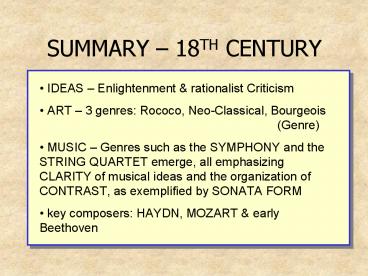SUMMARY 18TH CENTURY - PowerPoint PPT Presentation
1 / 17
Title:
SUMMARY 18TH CENTURY
Description:
MUSIC Genres such as the SYMPHONY and the STRING QUARTET emerge, all ... Classical Music. 1770-1820. Mozart. Only 35 years on the planet. Mozart listening example ... – PowerPoint PPT presentation
Number of Views:99
Avg rating:3.0/5.0
Title: SUMMARY 18TH CENTURY
1
SUMMARY 18TH CENTURY
- IDEAS Enlightenment rationalist Criticism
- ART 3 genres Rococo, Neo-Classical,
Bourgeois (Genre) - MUSIC Genres such as the SYMPHONY and the
STRING QUARTET emerge, all emphasizing CLARITY of
musical ideas and the organization of CONTRAST,
as exemplified by SONATA FORM - key composers HAYDN, MOZART early Beethoven
2
Classical Music
1770-1820
3
Mozart
Only 35 years on the planet
4
Mozart listening example
first movement from Symphony No. 35 in D Major,
K. 385, "Haffner" -- begins with a huge leap the
re is a variety of articulations and textures
-- clarity of texture and clarity of musical
ideas -- sonata form the modulation to the seco
nd theme/key is complete at about 130 the
development section starts at about 234 the
recapitulation begins at about 329.
-- major key -- the development section plays wi
th the contrast of minor keys to the home key of
the piece, which is major
5
Mozart
40 symphonies string quartets piano sonatas
27 piano concertos
masses 20 operas
6
Opera evolution
Baroque
recitative aria (solo) recitative aria recitative
. . . action emote action emote action . .
.
Classical/Mozart
recitative aria (solo) recitative ensemble . . .
action emote action emotion action ...
contrasting emotions
7
Mozart and opera
-- all voice ranges used (instead of the
Baroques treble bass preference)
-- ensembles (groups of solo voices) now
contrasted with arias and recitative
-- several operas about contemporary characters,
not mythological figures or ancient history from
Rome or Greece (although he did a few of those,
too) -- biting social commentary the decadent ar
istocracy is compared to the normal, happy,
healthy lust and love of the common folk
-- recitative still used -- some in German with
spoken dialogue
8
Mozart and opera
The three Da Ponte operas Marriage of Figaro (17
86) (play by Beaumarchais) Don Giovanni (1787)
Così Fan Tutte (1790)
Which one to choose as most representative?
(libretto little book, the story and words
for an opera)
Da Ponte librettist
9
Mozart viewing example
Cosi fan Tutte (they all do it)
3 pairs of voices symmetry of design appeals to
the Neo-Classical mind Rococo moral stance Rarel
y performed in the 1800s now regarded as one of
Mozarts finest operas Ends with an appeal for fo
rgiveness HUMAN REASON
10
Fragonard,The Swing,1769
Rococo
11
Petit Trianon, Versailles, France 1764 (Louis
XVI) NEO-CLASSICAL
12
Mozart viewing example
Don Giovanni Don Juan as anti-hero critique of
aristocracy (a proud anti-hero, though perhaps
a reflection of the Enlightenment attitude about
religion?) Rarely performed in the 1800s now re
garded as one of Mozarts finest operas 1787
13
The Marriage of Figaro(Le Nozze di Figaro)
- celebration of the common people v. the
decadent aristocracy - 1786
Bourgeois (Genre)
Chardin The Prayer before Meal1744
14
Mozart listening example
-- finale from Act II of The Marriage of Figaro
-- an ensemble scene (six voices)
-- contrasting emotions presented simultaneously
(compare that to the Baroque ideal aesthetic of
Affect, one mood or emotion per piece)
15
SUMMARY 18TH CENTURY
- IDEAS Enlightenment rationalist Criticism
- ART 3 genres Rococo, Neo-Classical,
Bourgeois (Genre) - MUSIC Genres such as the SYMPHONY and the
STRING QUARTET emerge, all emphasizing CLARITY of
musical ideas and the organization of CONTRAST,
as exemplified by SONATA FORM - key composers HAYDN, MOZART early Beethoven
16
Date data
Caravaggio, The Calling of St Matthew Baroque
beginnings
1600 1742
Handels Messiah oratorio
1776 Amer. Rev.
1787
J.L. DavidDeath of Socrates Mozart, Don Giovanni
1789 French Rev.
17
Mozart viewing example
Cosi fan Tutte (they all do it)
3 pairs of voices symmetry of design appeals to
the Classical mind

